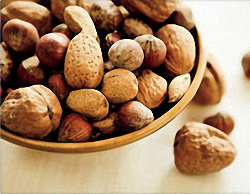- Fruits & Vegetables
- GMOs & Organics?
- Benefits of Grains
- What's a Carb?
- Low Carb Substitutes
- Proteins: Building Blocks
- Protein-Packed Breakfasts
- Meats: Keep it Lean
- Dairy Health Benefits
- Importance of Vitamin D
- Artificial Sweeteners
- Eating a Healthy Diet
- Fiber Sources & Benefits
- How Much Water?
- Example 2 Day Meal Plan
- Mediterranean Diet Pyramid
- Nutrition Facts Label
- Vitamins & Minerals
- U.S. Dietary Guidelines
protein: building blocks
 |
The protein food group includes meat, poultry and fish as well as beans, eggs and even seeds and nuts. There are several foods from some of the other food groups that are a good source of protein as well such as cottage cheese and Greek-style yogurt from the dairy group and lentils from the grains group. |
||
|
When we eat protein, our body breaks these large molecules down into smaller units called amino acids. These building blocks are used for many important functions in the body, including growth and repair of muscle, connective tissue and skin. Amino acids are also needed for building hormones, blood proteins and enzymes. While protein can be used by the body for energy, the first priority is to keep the body strong. There are 20 amino acids that we must obtain from food sources; these are called "essential amino acids." When we talk about a "complete protein," we're referring to a food that contains all these essential amino acids. A potato, for example, contains amino acids, but because it's missing several of the essential ones, it's not a complete protein. Our bodies can also make several amino acids and these are called "non-essential" amino acids. When making your selection of protein, you'll want to watch out for the fat that comes along with the protein. For example, beef and egg yolks are a source of saturated fat, which is the type of fat we want to eat in moderation. Fish and nuts are also a rich source of fats, but they contain a different kind of fat called "monounsaturated" which can be part of a healthy diet as long as you are watching your portions.
|
|||
